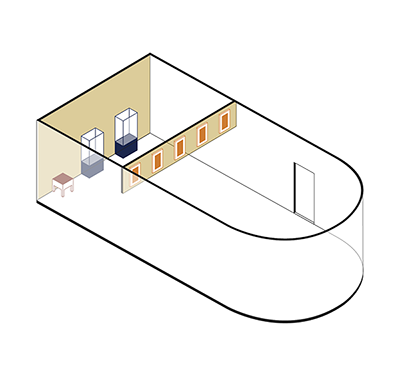ABR 046
Code: ABR 046
Country: Tibet (central)
Style:
Date: 1150 - 1250
Dimensions in cm WxHxD: 3.7 x 16.8 x 3.7
Materials: Iron
Nine-pronged diamond sceptre (navasucika-vajra)
The vajra (Skt.) - dorje (Tib.) is generally interpreted as "diamond scepter" and represents the male principle (compassion). Together with its female equivalent, the bell (ghanta), which represents wisdom, the pair occupies the principal place in the hierarchy of ritual objects.
Vajras may have three, five or nine spokes. The spokes of a “peaceful vajra” meet at the tip, whereas those of a “wrathful vajra” are slightly splayed at the end. Nine-pronged vajras belong to the latter category and are used in rituals of domination and destruction of inner obstacles on the way to liberation.
As a short metal weapon, it has the nature of a diamond (it can cut any substance but cannot be cut itself) and of the thunderbolt (irresistible force). The vajra has thus come to represent firmness of spirit and spiritual power. It is the symbol of Vajrayana, one of the three major branches of Buddhism. Vajrayana translates as "Thunderbolt Way" or "Diamond Way" and thus implies the thunderbolt experience of Buddhist enlightenment or bodhi. In the tantric traditions of both Buddhism and Hinduism, the vajra is a symbol for the nature of reality, or shunyata, indicating endless creativity, potency, and skillful activity.
The vajra (Skt.) - dorje (Tib.) is generally interpreted as "diamond scepter" and represents the male principle (compassion). Together with its female equivalent, the bell (ghanta), which represents wisdom, the pair occupies the principal place in the hierarchy of ritual objects.
Vajras may have three, five or nine spokes. The spokes of a “peaceful vajra” meet at the tip, whereas those of a “wrathful vajra” are slightly splayed at the end. Nine-pronged vajras belong to the latter category and are used in rituals of domination and destruction of inner obstacles on the way to liberation.
As a short metal weapon, it has the nature of a diamond (it can cut any substance but cannot be cut itself) and of the thunderbolt (irresistible force). The vajra has thus come to represent firmness of spirit and spiritual power. It is the symbol of Vajrayana, one of the three major branches of Buddhism. Vajrayana translates as "Thunderbolt Way" or "Diamond Way" and thus implies the thunderbolt experience of Buddhist enlightenment or bodhi. In the tantric traditions of both Buddhism and Hinduism, the vajra is a symbol for the nature of reality, or shunyata, indicating endless creativity, potency, and skillful activity.


